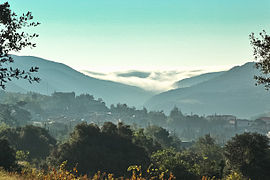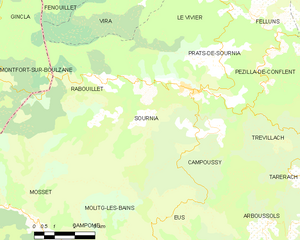Sournia
Sournia
Sornian | |
|---|---|
 A general view of Sournia | |
| Country | France |
| Region | Occitania |
| Department | Pyrénées-Orientales |
| Arrondissement | Prades |
| Canton | Sournia |
| Government | |
| • Mayor (2001–2008) | Paul Blanc |
Area 1 | 29.99 km2 (11.58 sq mi) |
| Population (1999) | 367 |
| • Density | 12/km2 (32/sq mi) |
| Time zone | UTC+01:00 (CET) |
| • Summer (DST) | UTC+02:00 (CEST) |
| INSEE/Postal code | 66198 /66730 |
| Elevation | 380–1,234 m (1,247–4,049 ft) (avg. 500 m or 1,600 ft) |
| 1 French Land Register data, which excludes lakes, ponds, glaciers > 1 km2 (0.386 sq mi or 247 acres) and river estuaries. | |
Sournia (Sornian in the Occitan language) is a commune in the Pyrénées-Orientales department in the Languedoc-Roussillon region of south-western France. Its inhabitants are known as Sourniannais.
Geography
Sournia is a town of the Fenouillèdes, the languedocienne part of the Pyrénées-Orientales, in the canton of Sournia and in the arrondissement of Prades. The river Désix runs through the village. Sournia is 22 km from Ille-sur-Têt and from Vinça, 24 km from Prades and from Saint-Paul-de-Fenouillet, 30 km from Latour-de-France and 34 km from Axat.
The commune is covered by the quality wine standard AOC 'Côtes-du-Roussillon'.
Sournia is crossed by the long distance footpath, GR 36.

Administration
The current mayor of Sournia is Paul Blanc, a senator, of the centre-right and right wing party UMP founded by Jacques Chirac.
Population
The population of Sournia in 2013 was 501 people.
Graph of population change 1794-1999

Places of interest
- Ruins of the former church of Saint-Michel from the tenth century.
- The ancient church of Sainte-Félicité from the tenth and eleventh centuries.
- Church of Arsa from the twelfth century.


